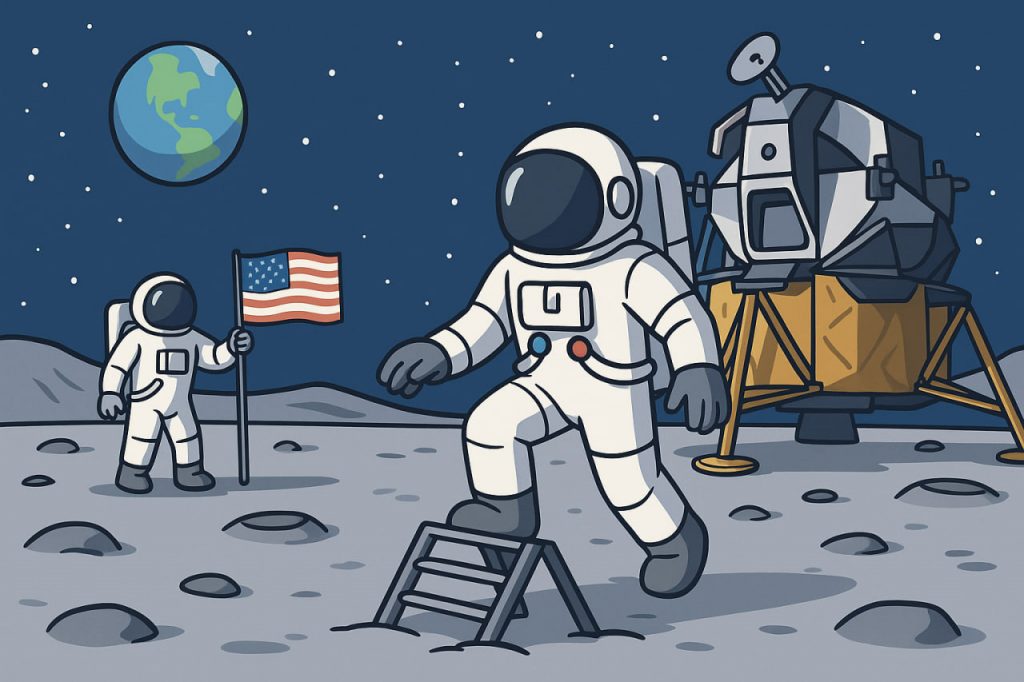On July 20, 1969, millions of people across the globe watched in awe as Neil Armstrong stepped onto the surface of the Moon, delivering the iconic words: “That’s one small step for [a] man, one giant leap for mankind.” The Apollo 11 mission was not just a technical achievement, but a symbol of what humanity could accomplish through science, perseverance, and international effort. It marked the first time humans set foot on another celestial body.
Background: The Race to the Moon
The Moon landing was the result of years of Cold War rivalry between the United States and the Soviet Union. After the Soviets launched Sputnik 1 and sent Yuri Gagarin into space, the U.S. intensified its efforts to lead in space exploration. In 1961, President John F. Kennedy declared the national goal of sending a man to the Moon and returning him safely to Earth before the decade’s end.
This led to the development of NASA’s Apollo program, a massive project involving over 400,000 engineers, scientists, and workers.
Apollo 11: Mission Overview
The Apollo 11 mission was launched on July 16, 1969, aboard the Saturn V rocket, the most powerful rocket ever built at the time. The crew included:
- Neil Armstrong – Mission commander
- Buzz Aldrin – Lunar module pilot
- Michael Collins – Command module pilot (remained in orbit)
After a three-day journey through space, the spacecraft entered lunar orbit.
Landing on the Moon
On July 20, the lunar module “Eagle” separated from the command module. Armstrong and Aldrin carefully descended toward the surface, manually piloting the module to avoid boulders. At 20:17 UTC, Armstrong announced:
“The Eagle has landed.”
Hours later, Armstrong became the first human to walk on the Moon, followed by Aldrin. They:
- Spent 2.5 hours walking on the surface
- Collected 21.5 kg of rock and soil samples
- Planted the U.S. flag
- Left a plaque that read: “We came in peace for all mankind.”
Meanwhile, Collins remained in lunar orbit, ensuring the safe return of the crew.
Return to Earth
After 21 hours on the Moon, Armstrong and Aldrin lifted off in the lunar module and rejoined Collins. The crew safely returned to Earth on July 24, landing in the Pacific Ocean, where they were recovered by the USS Hornet.
Upon return, the astronauts were placed in quarantine for 21 days to ensure they had not brought back any unknown pathogens.
Scientific and Cultural Impact
The first Moon landing:
- Demonstrated that interplanetary travel was possible
- Advanced our understanding of lunar geology
- United people across the world in a moment of shared wonder
- Inspired generations of scientists and engineers
The Apollo program continued with five more Moon landings, but Apollo 11 remains the most iconic.
There is an opinion that the landing of a man on the moon was a staged film and never really happened. Therefore, I recommend that those who are looking for the truth should search for themselves and familiarize themselves with videos and scientific materials on this topic.
Glossary
- Apollo 11: The NASA mission that carried out the first Moon landing.
- Saturn V: A powerful rocket used to launch astronauts to the Moon.
- Lunar module (Eagle): The spacecraft used to land on the Moon’s surface.
- Command module: The main spacecraft used for travel to and from the Moon.
- Lunar orbit: The path followed around the Moon before and after landing.
- Moonwalk: Walking on the Moon’s surface in a space suit.


